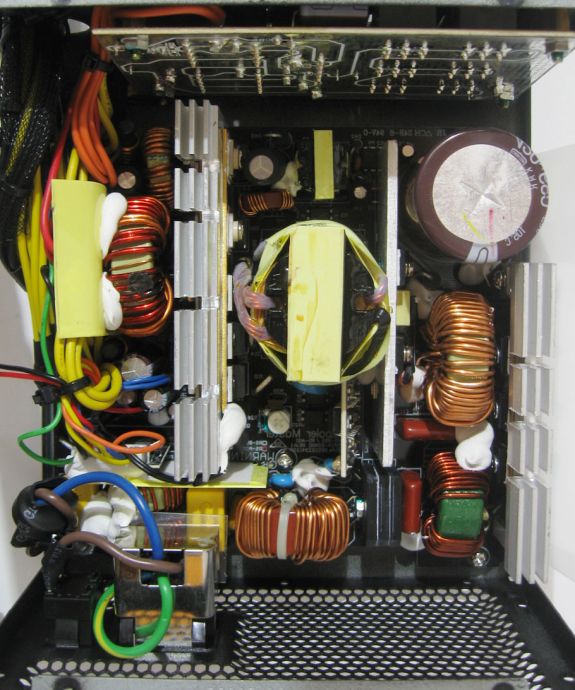Cooler Master Silent Pro M1000 1000W
by Martin Kaffei on September 5, 2010 10:30 PM EST- Posted in
- Cases/Cooling/PSUs
- PSUs
- 80Plus
- Cooler Master
- Silent Pro
Interior/Design
The distinctive protective foil on the input will clue some readersin: the electronics are manufactured by FSP. Notwithstanding the ODM, the configuration depends on what Cooler Master asks for, and this area shows some decent expenditures.
The EMI filtering consists of four Y- and four X-capacitors. Additionally two common mode chokes can be found, as well as a ferrite core, which is wrapped by phase and neutral cord. In contrast to many PSUs two linear chokes are used to compensate differential mode interferences. Not least we find an MOV. The power switch has been insulated with shrink tubing as it’s relatively close to the main PCB, but the highlight is neither the input-side filter nor the abundantly measured 680 µF filtering capacitor by Nippon-Chemicon (KMR, 105°C for 2000 hours until 20% of the capacity will be lost).
On the secondary circuit, where temperatures rise and space is scarce, high quality capacitors are used. We sometimes have discussed the usefulness of Japanese capacitors. When they are used sensibly in a high-end PSU, the choice will be a welcome one, and Cooler Master uses a good choice of Rubycon along with Nippon-Chemicon capacitors. This shows that Cooler Master doesn’t want to use the primary capacitor as an eye catcher and stint on the secondary side, but also uses high-grade parts there.
On +12V the Rubycon MBZ-series are used, which can be found on many motherboards but seem to harmonize quite well in power supplies. These are characterized by a low ESR (resistance), which resembles the losses in the capacitor. So low-ESR capacitors contribute their part to the general efficiency. On +3.3V and +5V mainly the YXG-model is used, which can take high ripple current and is specified for a lifespan of 6000 hours at 105°C. That are respectable qualities, which not only refer to these special components.
We often have pointed out that the weakest part limits the performance of the whole PSU and the quality of the capacitors is not the only feature that matters. The well-dimensioned rectifier bridges suit the well-dimensioned main capacitor and the EMI filtering suits the secondary setup. External as well as internal interferences are compensated by large filtering stages. Not least a Silicon Touch protection-IC is used, which offers OTP besides the usual functions and isn’t very common. Two measuring diodes check the temperature of the secondary heat sink and control the fan speed or shut down the PSU before the temperature gets too high.
But of course, good capacitors have their right to exist as well. Besides the quality, the number and presence of capacity is crucial to improving the voltage quality. On the cable management PCB, whose cables and connectors are soldered well, additional Nippon-Chemicon capacitors are smoothing the output voltage. We will see whether this can be noticed in our further measurements. The only point of criticism is a slightly loose PFC-choke as a point of hot glue was not set precisely enough.











22 Comments
View All Comments
FinBenton - Monday, September 6, 2010 - link
I have this PSU, it has been working ok but computer cannot go to sleep with this psu and fan is definitely audible even when no stress on hardware.Beenthere - Monday, September 6, 2010 - link
Don't care for the flat cables at all. They are a PITA and obstruct airflow. With quiet fans available there is little need for noise these days.hsew - Monday, September 6, 2010 - link
It's too bad we don't see more PSU reviews from this site more often. This is one of the few sites that properly tests PSUs.redwolfe98 - Tuesday, September 7, 2010 - link
every review of a "cooler master" power supply that i read mentions some defect..having half of the air-intake blocked is stupid..
pkoi - Tuesday, September 7, 2010 - link
Heatsinks have way too little surface area.pkoi - Tuesday, September 7, 2010 - link
What a piece of S...Imagginer - Tuesday, September 7, 2010 - link
Power Supplies this strong are made for CF and SLI gymnastics, right? So if you've got 2 or 3 high end graphic cards stacked how are you going to cool them? Passively?....I don't think so. Now, I dont know how load those coolers are going to be but one can bet they're gonna be loader than 20dba......so this fuss about 20dba being too load is irrelevant or should we say ridiculous...If you're building audio workstation...that's another story....but you're not gonna need 1000W, thats for sure...
Imagginer - Tuesday, September 7, 2010 - link
PS.Who needs 1000W PS anyway.... 99,9999% of people get nothing with it but bragging rights...
My 625W Enermax is more than I will ever need and even with that I often ask myself if I ever am gonna need that much power.... taking into consideration that my i7 920 and HD 4870 are not exactly 'power saving components'....
jdietz - Tuesday, September 7, 2010 - link
Agreed. 1kW is far too much for most PCs. One of my PCs has 380W PS and the other has 330W PS. Both have a video card installed. If you have only one video card (read: 90% of PC owners), you don't need over 350W.Martin Kaffei - Tuesday, September 7, 2010 - link
Hi,for my next review I got an Antec Earth Watts Green 380W. Hope, you'll like it.